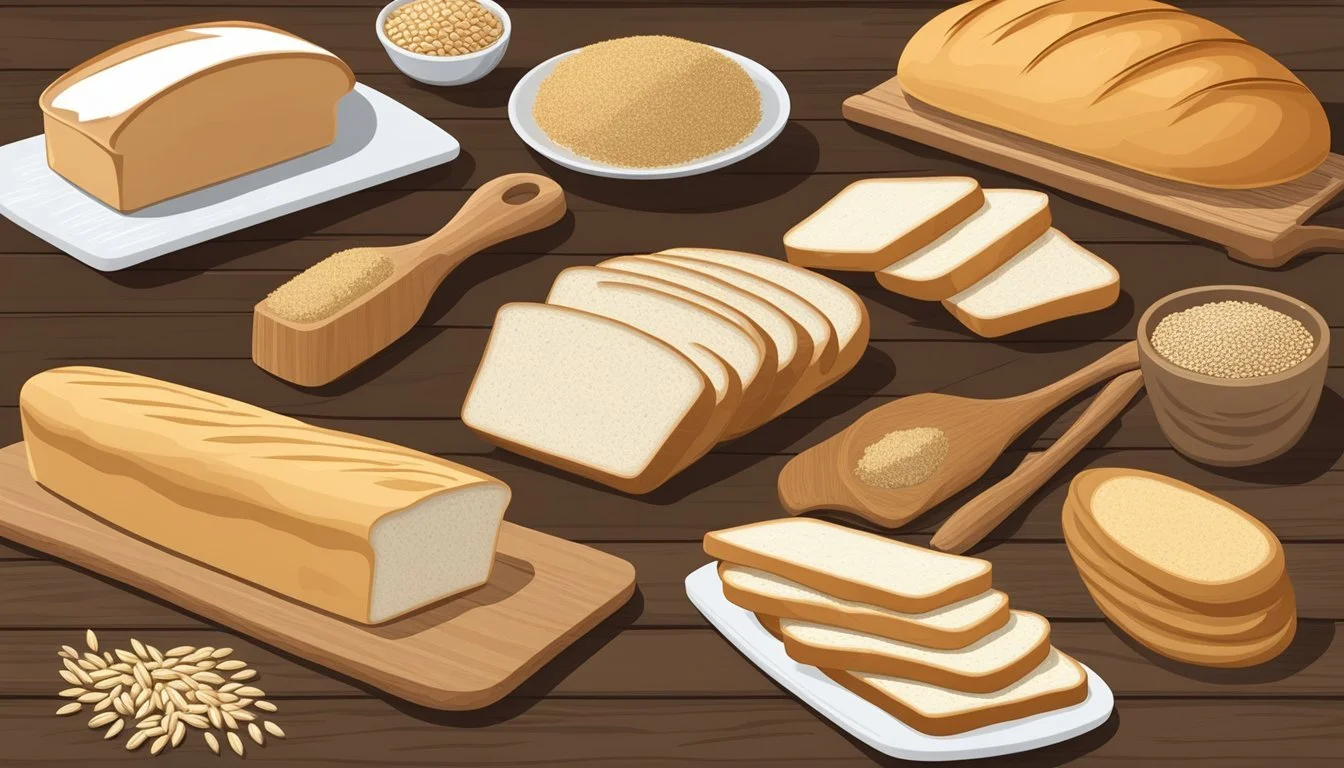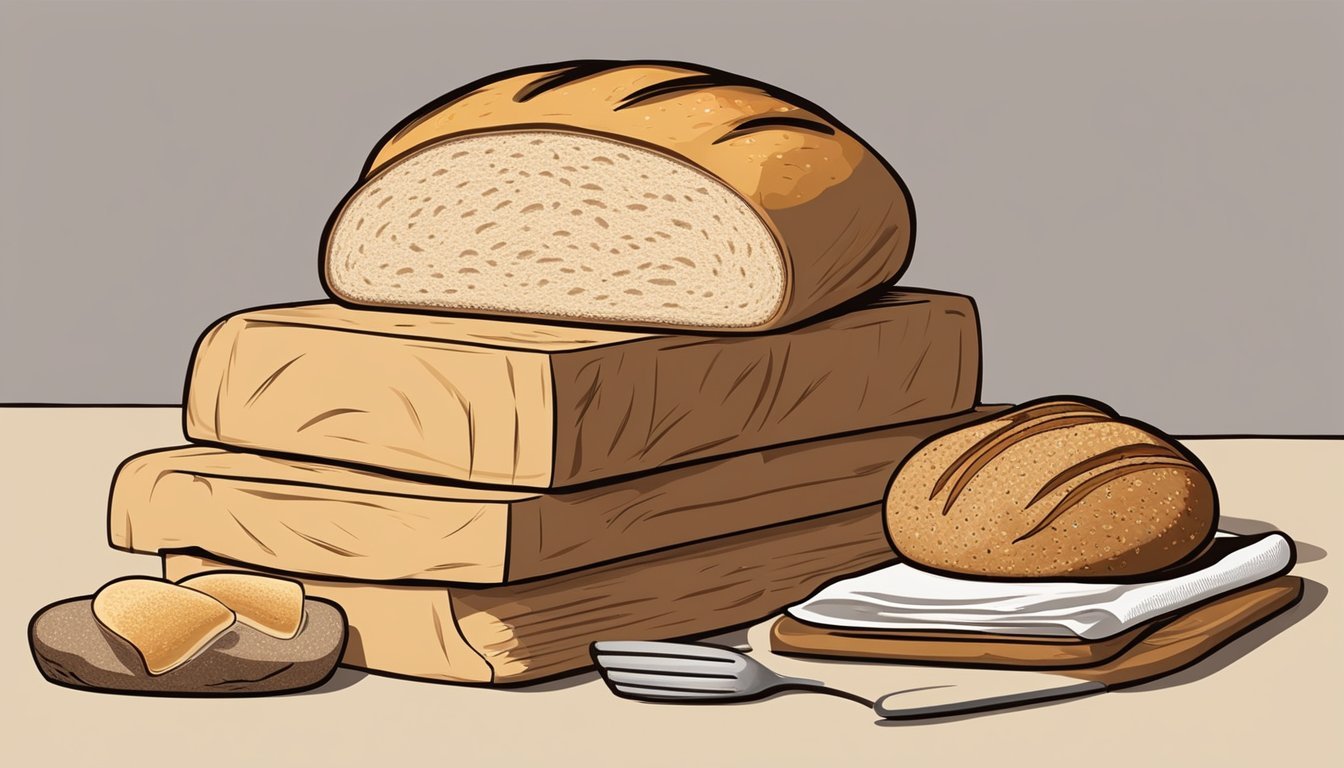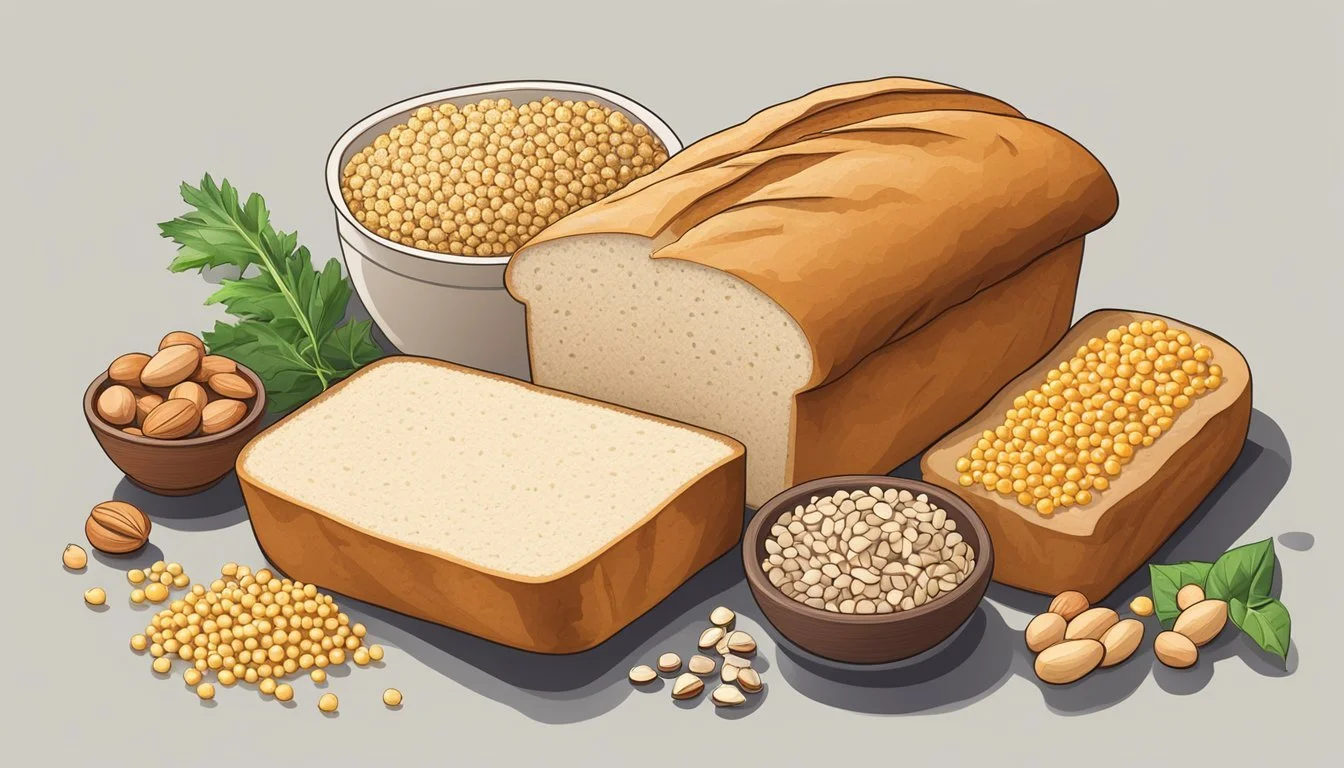White Bread Substitutes
5 Healthier Alternatives for Your Diet
White bread has long been a staple in many diets, prized for its soft texture and adaptability. However, its nutritional profile and effects on blood sugar levels raise concerns. White bread is typically made from refined flour, which lacks the fiber and nutrients found in whole grain alternatives. Its high glycemic index means that it can lead to rapid spikes in blood sugar levels, which is suboptimal for sustained energy and overall health.
In response to these nutritional shortcomings, a growing number of alternatives have surfaced. These substitutes aim to offer better nutritional benefits, such as higher fiber content, lower glycemic index, or additional vitamins and minerals. Some popular substitutes include sourdough, which, due to its fermentation process, may be easier to digest and have a more favorable impact on blood sugar levels. Others opt for bread made from whole grains or seeds, providing a richer array of nutrients and a steadier release of energy.
In addition to traditional bread types, innovative replacements such as lettuce wraps, cauliflower crusts, and egg wraps cater to those on low-carb or ketogenic diets. These alternatives often mimic the texture and role of bread in meals while providing additional health benefits, such as lower carbohydrate content and an increase in vegetable intake. Transitioning to these alternatives can be a step towards a more diverse and nutritionally balanced diet.
Understanding White Bread and Its Impact
White bread, while a common component in many diets, has a simplified nutrition profile and specific health implications that merit discussion. This section explores its nutritional makeup, the potential health concerns linked with refined wheat, and the role the glycemic index plays in blood sugar regulation.
Nutrition Profile of White Bread
White bread is typically made from refined wheat flour, where the grain's bran and germ have been removed. This process significantly reduces the content of fiber, vitamins, and minerals. A typical slice of white bread contains the following nutrients:
Nutrient Amount per slice Energy 66 kcal Protein 2 g Fat 0.8 g Carbohydrates 13 g Fiber 0.6 g Sugars 1.3 g
The resulting product is rich in simple carbohydrates with a lack of essential nutrients compared to its whole grain counterparts.
Health Implications of Refined Wheat Consumption
Consuming foods made from refined wheat, such as white bread, has been associated with various health issues. Refined grains are linked with a higher risk of weight gain, type 2 diabetes, and heart disease. These products often lack essential nutrients found in whole grains, which are important for digestive health and maintaining a healthy metabolism. Additionally, they contain gluten, a protein that can cause adverse reactions in individuals with gluten-related disorders.
The Role of Glycemic Index in Blood Sugar Management
The glycemic index (GI) is a measure that ranks foods on how they affect blood sugar levels. White bread has a high GI, typically around 73, which means it can cause rapid spikes in blood sugar levels. This is particularly concerning for individuals with diabetes who require careful blood sugar management. Foods with a lower GI are preferred as they result in a slower, more gradual increase in blood sugar, aiding in overall blood sugar control.
By choosing alternatives to white bread, consumers can enjoy a more complex nutrition profile, potentially reduce the risk of certain health conditions, and manage blood sugar levels more effectively.
Criteria for Choosing Bread Substitutes
When selecting bread substitutes, individuals should consider nutritional content, manage dietary restrictions such as celiac disease, cater to personal taste and texture preferences, and balance convenience with health benefits.
Nutritional Considerations
Nutrition is paramount when choosing a bread alternative. Ideal substitutes should be high in fiber and protein to promote satiety and support digestive health. Whole grains or breads made from nutrient-dense flours like almond or coconut flour are excellent choices due to their reduced carbohydrate content and higher nutritional value.
Managing Gluten Sensitivity and Celiac Disease
For those managing gluten sensitivity or celiac disease, gluten-free options are essential. Bread substitutes made from gluten-free grains or pseudocereals like buckwheat, quinoa, or tapioca flour can provide the necessary dietary compliance without compromising on flavor or variety.
Taste and Texture Preferences
Taste and flavor profiles vary significantly across different bread substitutes. Some may prefer the nuttiness of whole-grain alternatives, while others might opt for milder options like rice paper or lettuce wraps. Texture-wise, substitutes can range from the chewiness of gluten-free bread to the crispness of cucumber slices, catering to individual preferences.
Balancing Convenience with Health Benefits
Convenience plays a crucial role, especially for those with busy lifestyles. While pre-packaged gluten-free breads offer quick alternatives, making homemade substitutes like cloud bread or using raw vegetables as bread can maximize nutrition without added preservatives or sugars found in store-bought options.
Popular White Bread Substitutes
A shift towards healthier eating often includes replacing white bread with more nutritious alternatives. Below are some of the preferred options.
Whole-Grain Bread Varieties
Whole-grain breads are a direct substitute for traditional white bread. They preserve the texture and versatility people are accustomed to but with added health benefits. Whole-wheat bread is dense in nutrients and higher in fiber. Sourdough is another popular choice, with its tangy flavor and unique fermentation process that can aid in digestion.
Gluten-Free Breads
For those with gluten sensitivities or celiac disease, gluten-free breads offer a safe alternative without sacrificing the joy of enjoying bread-like products. Wraps made from gluten-free grains or starches serve as excellent vehicles for sandwich ingredients and are widely available in most markets.
Low-Carb Alternatives
Low-carb options cater to those monitoring their carbohydrate intake. Alternatives like flaxseed or almond flour bread reduce carbs significantly. For a ready-to-eat option, many seek out pre-packaged low-carb breads which are formulated to mimic the texture and taste of white bread.
Using Vegetables as Bread Replacements
Creative and health-conscious efforts have led to using vegetables as stand-ins for bread. Lettuce wraps are a crunchy, refreshing replacement, perfect for encasing sandwich fillings. Cauliflower is transformed into various forms such as pizza bases and tortillas, providing not only a low-carb bread substitute but also an extra serving of vegetables.
Grain-Based Bread Alternatives
These alternatives to traditional white bread not only offer a variety of flavors and textures but also provide added nutritional benefits such as increased fiber, nutrients, and digestibility due to their unique grains and preparation methods.
Sourdough and Fermented Grain Options
Sourdough bread is a product of fermentation, a process that leverages natural bacteria to break down starches and gluten in grains, making nutrients more accessible. Because of its fermented nature, sourdough often has a tangy taste and a lower glycemic index, favoring blood sugar control.
Sprouted Grain and Ezekiel Bread
Breads made from sprouted grains are produced using seeds that have begun to sprout before being milled into flour. Ezekiel bread, a specific type of sprouted grain bread, combines wheat, millet, barley, and spelt, and sometimes includes legumes like lentils and soybeans. This combination results in a complete protein, offering all nine essential amino acids.
Flatbreads and Tortillas
Tortillas, a staple in many cultures, present a versatile bread substitute. Available in both flour and corn varieties, whole grain versions provide more nutrients and fiber. Flatbreads, also made from grains like oats or barley, can be enriched with herbs and spices, turning a simple bread alternative into a flavorful component of any meal.
Ancient Grains and Their Uses
Ancient grains such as millet, spelt, and rye have stood the test of time with their robust flavors and nutrient profiles. These grains are often present in breads marketed as gluten-free options due to their suitability for those with gluten sensitivities. Using these grains can enhance the fiber content and add a variety of minerals to one's diet.
Vegetable-Based Options for Bread Substitution
Substituting white bread with vegetables not only adds a nutritious twist but can also provide unique flavors and textures that bread simply cannot. These vegetable-based alternatives cater to various dietary needs, including gluten-free and low-carb lifestyles.
Lettuce and Leafy Greens as Wraps
Lettuce wraps serve as a crunchy, low-calorie substitute for bread. They are perfect for encasing a variety of fillings, from traditional taco meat to Asian-inspired stir-fries.
Types of Lettuce for Wraps:
Iceberg: Firm and crunchy, holds up well as a wrap.
Butterhead: Softer texture, ideal for lighter fillings.
Romaine: Long leaves, suitable for heavier contents.
Cauliflower Crusts and Breads
Cauliflower is a versatile vegetable that can be transformed into a dough-like consistency to make crusts and breads. High in nutrients and low in carbs, cauliflower crusts are favored in gluten-free and ketogenic diets.
How to Make Cauliflower Bread:
Rice the cauliflower and remove excess moisture.
Combine with binding agents like egg or cheese.
Shape and bake until golden and firm.
Sweet Potato as a Bread Alternative
Sweet potato offers a naturally sweet and nutritious base for toppings. Slice it thickly to create sweet potato toast, a flavorful replacement for traditional toast or sandwich bread.
Sweet Potato Toast Tips:
Slice evenly for consistent cooking.
Lightly coat with oil and season for extra flavor.
Bake until edges are crispy.
Mushroom and Eggplant Slices for Sandwiches
Thick slices of mushrooms and eggplants provide a substantial, meaty texture perfect for making sandwiches (What wine goes well with sandwiches?). Portobello mushrooms are especially ideal due to their large size and robust flavor.
Preparation for Portobello Buns:
Remove stems and gills for a smoother surface.
Marinate and grill for enhanced taste.
Eggplant Prep:
Slice into rounds.
Season and grill or roast until tender.
Protein-Rich Substitutes for White Bread
Transitioning from white to protein-rich bread substitutes offers additional nutrition and can align with low-carb diets. Here are some specific alternatives that are high in protein and can replace traditional white bread.
Legume-Based Breads and Wraps
Legume-based breads are excellent sources of protein, often made from ingredients like lentils, chickpeas, and soybeans. These options not only provide a protein boost but also fiber, which aids in digestion. Wraps made from legumes can also serve as a nourishing alternative for sandwich lovers.
Example: Chickpea flatbread contains approximately 7 grams of protein per serving.
Cheese and Eggs as Low-Carb Options
Eggplant rounds topped with melted cheese create a low-carb, protein-rich alternative to traditional breads. Cloud bread, made primarily from eggs, is another low-carbohydrate option, offering a fluffy texture akin to bread without the excess carbs.
Example: A medium eggplant slice with cheese can provide around 5 grams of protein.
Meaty and Deli Options for Bread Replacement
Thinly sliced meat can be used to wrap sandwich fillings, effectively cutting carbs while increasing protein intake. Deli meats like turkey and chicken are common selections for those seeking to maintain a high-protein diet.
Example: Two slices of turkey used as a wrap can contain about 13 grams of protein.
Creative Alternatives to Traditional Sandwiches
Seeking to reduce carbs or add variety, individuals can explore numerous substitutes for white bread in sandwich-making. These alternatives not only cater to dietary preferences and restrictions but also offer new textures and flavors.
Using Nuts and Seeds in Bread Recipes
Nut and seed breads incorporate ingredients like almonds, flax, or chia, which are grounded into flour and used in recipes. This approach transcends the conventional sandwich bread by offering a robust nutty flavor and is rich in proteins and healthy fats. Breads crafted from almond flour or with added pumpkin seeds can elevate the nutritional profile and taste of any sandwich.
Cloud Bread and Other Egg-Based Creations
Cloud bread—a light, high-protein bread substitute—is made predominantly with egg whites and cream cheese. It sits prominently among alternatives as it resembles traditional bread in texture while being gluten-free and low in carbohydrates. Recipes for cloud bread are straightforward, with a simple mix, bake, and puff process, resulting in a soft and versatile bread replacement.
Vegetable and Protein Stacks
Vegetables like eggplants can be transformed into hearty slices that replace bread slices in sandwiches and stacks. They provide vital nutrients and a savory foundation for a variety of fillings. Protein-packed slices, such as grilled chicken or tofu, can also perform as the bread substitute in a sandwich, creating a double dose of protein and limiting carb intake.
Burger and Pizza Alternatives Without Bread
For burger aficionados, portobello mushroom caps offer a juicy and flavorful replacement for the traditional bun. They can be grilled or baked and provide a substantial structure to any burger. Similarly, pizza crust can be reimagined using cauliflower or ground chicken, establishing a lower-carb foundation that crisps nicely and supports all the classic pizza toppings.
Shopping for Bread Substitutes
When looking for bread substitutes, shoppers are advised to seek out options that are high in fiber and low in calories, prioritizing whole-grain selections to maximize nutritional benefits.
Navigating the Grocery Store for Healthy Choices
Grocery stores and supermarkets often have a variety of bread alternatives. To make healthier choices, one should head towards the bakery or health food section where whole-grain breads are typically shelved. Markets may also offer a range of artisanal and freshly-made options which can include nutrient-dense substitutes like sourdough or sprouted grain breads.
Reading Labels and Nutrient Content of Bread Substitutes
It's imperative to read nutrition labels when choosing a bread substitute to understand the nutrient content. A good substitute will:
Lower Calories: Ideal for those monitoring their intake.
Higher Fiber: A minimum of 3 grams per slice is beneficial.
Reduced Antinutrients: Some options have fewer antinutrients, which can inhibit the absorption of minerals.
Here's what to look for in nutrition labels:
Total calories per serving
Fiber content (aim for higher numbers)
Presence of whole grains as the first ingredient
Tips for Choosing Low-Calorie and High-Fiber Options
When selecting low-calorie and high-fiber bread substitutes, consider these tips:
Opt for Whole-Grain: Not only are they packed with nutrients but also contain essential fiber.
Experiment with Grains: Try breads made from barley, oats or spelt. Each offers a unique nutrient profile.
Alternative Flours: Look for breads using almond, coconut, or oat flours which can be lower in calories and offer different nutritional advantages.
Remember that each choice impacts the overall nutrition profile of your diet. Make selections that complement your health goals and dietary needs.
Home Baking and Bread Substitute Recipes
In the quest for healthier alternatives to white bread, home baking rises as an empowering solution. By baking at home, one has control over the ingredients, ensuring the use of nutritious options such as gluten-free flours, a variety of flatbreads, and the inclusion of spices and healthy fats to enhance both flavor and health benefits.
Gluten-Free Flours and Baking Techniques
Individuals with gluten sensitivities or seeking healthier options often turn to gluten-free flour blends for their baking needs. Almond flour is a prominent choice, praised for its nutritional profile rich in protein and healthy fats. For successful results, bakers should weigh gluten-free flour for precision as it behaves differently compared to wheat flour. Here's a basic guideline for gluten-free baking:
Gluten-Free Flour Baking Tip Almond Flour Ideal for dense and moist baked goods. Coconut Flour Highly absorbent; requires additional liquids. Rice Flour Delivers a light texture. Oat Flour Offers a mild flavor; keep an eye on moisture.
Savoring Homemade Flatbreads
One can craft delicious flatbread recipes right in their own kitchen, venturing beyond the traditional white bread. These delectable breads can be made using various flours, incorporating spices to add distinct flavors. Flatbreads serve as a versatile base for wraps, pizzas, and sandwiches. They require minimal rising time, which appeals to those seeking a quick and healthy bread alternative.
Here's a simple flatbread recipe to try:
Combine 2 cups of whole wheat flour with water, a teaspoon of olive oil, and a pinch of salt.
Roll out the dough thinly and cook on a hot skillet until each side is golden brown.
Enhance the taste by adding a sprinkle of spices like cumin, garlic powder, or rosemary.
Experimenting with Spices and Healthy Fats
Adding spices to bread substitutes not only elevates the flavor but can also contribute various health benefits. Additionally, incorporating healthy fats like olive oil or avocado oil into recipes improves texture and satiety. One doesn't need to be an expert baker to start experimenting with spices in their homemade breads; even a small addition can make a significant difference in taste.
For a nutritious twist on traditional recipes:
Infuse dough with a teaspoon of turmeric or cinnamon for anti-inflammatory properties.
Brush flatbread with olive oil post-baking for a crispier crust and a dose of healthy fats.
Conclusion: Embracing Bread Substitutes for a Healthier Diet
In the pursuit of a healthier lifestyle, individuals are increasingly exploring alternatives to traditional white bread. The benefits of these substitutes often include more balanced blood sugar levels due to lower glycemic indices, contributing to a healthier diet overall. For those seeking a gluten-free option, substitutes like corn tortillas and cauliflower-based products offer nutritious choices without sacrificing taste.
Taste and Nutrition:
These alternatives are not mere imitations but possess their own unique flavors. Rye bread, for example, offers a denser, fiber-rich experience. Substitutes such as rice paper, cloud bread, and nori sheets also present new and interesting textures and tastes that can enhance a dish.
Healthy Lifestyle:
Adopting bread alternatives can align with a variety of dietary goals. Whether targeting weight management, a gluten-free regimen, or simply aiming for a diet that is easier to digest, there are numerous options available:
Whole grain breads
Egg wraps
Cauliflower creations (tortillas, pizza bases)
Lettuce leaves for wraps
Blood Sugar Management:
By choosing substitutes with lower carbohydrate content, people can manage their blood sugar more effectively, an important consideration for those with diabetes or prediabetic conditions.
Gluten-Free Options:
The growth of gluten-free diets has spurred on the availability of alternatives made from a range of non-wheat products, ensuring that nutritional needs can be met without gluten.
In summary, embracing bread substitutes can be a transformative step towards a more health-conscious diet. It allows for variety and innovation in meals, all while catering to specific dietary requirements.







